Brain Anatomy Part 1 (Week 1, Mod 8)
1/18
There's no tags or description
Looks like no tags are added yet.
Name | Mastery | Learn | Test | Matching | Spaced |
|---|
No study sessions yet.
19 Terms
Describe the embryological development of the CNS… what did it develop from?
Is initially derived from the neural plate of the embryo:
Specialized layer of ectoderm
Bends in, and embryo folds in on itself to form the neural tube
The neural crest is formed at the point where the two borders connected to form the tube
The neural crest forms the PNS
The neural TUBE forms the CNS
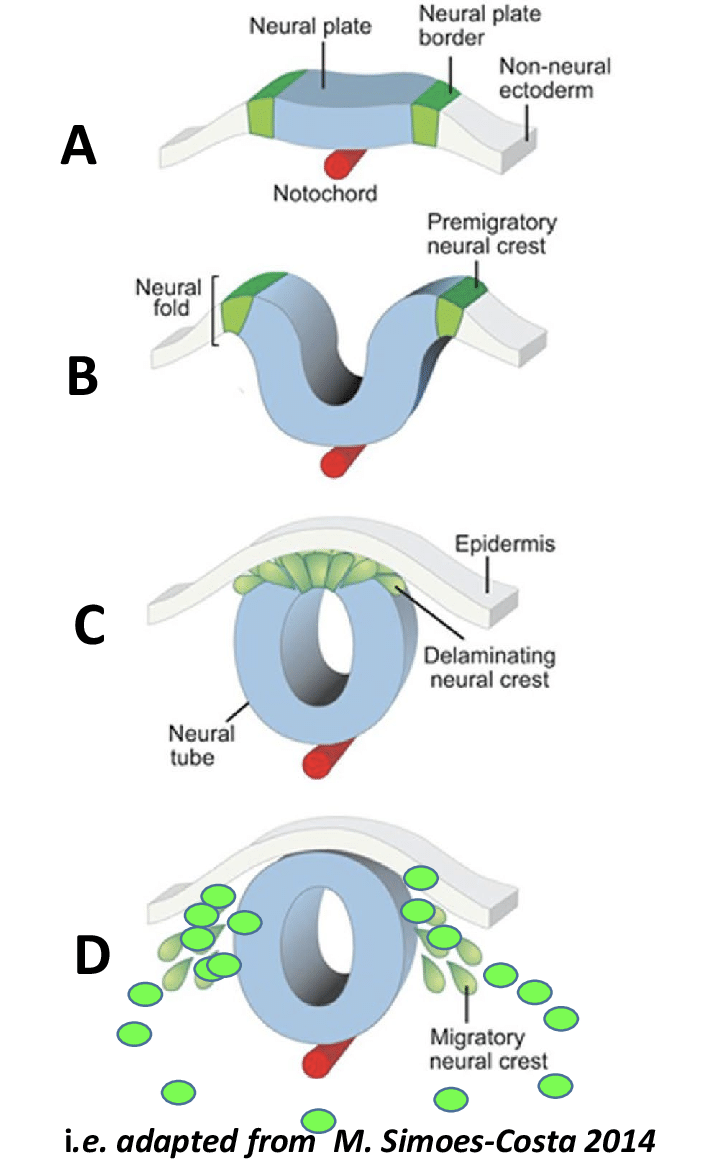
What 3 regions does the neural tube divide into when forming the CNS? What are these referred to as collectively?
Called the primary vesicles:
Prosencephalon (forebrain)
Mesencephalon (midbrain)
Rhombencephalon (hindbrain)
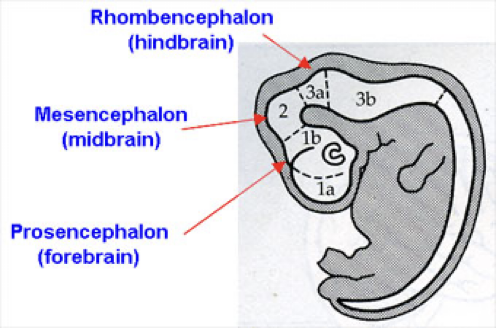
Further divisions develop as the embryo matures… what are these referred to as collectively? Describe the divisions that occur within the prosencephalon, mesencephalon, and rhombencephalon. What structures do these give rise to?
Are called the secondary vesicles
Forebrain → divides into telencephalon and diencephalon
Telencephalon:
Forms the cerebral hemispheres
Houses the lateral ventricles (in the brain)
Diencephalon:
Forms thalamus and hypothalamus
Also epithalamus and pineal gland
Midbrain → only the mesencephalon
Forms the midbrain
Includes cerebral peduncles (little feet) that connect cerebrum and midbrain
Hindbrain → divides into metencephalon and myelencephalon
Metencephalon:
Forms the pons and cerebellum
Myelencephalon:
Forms medulla oblongata
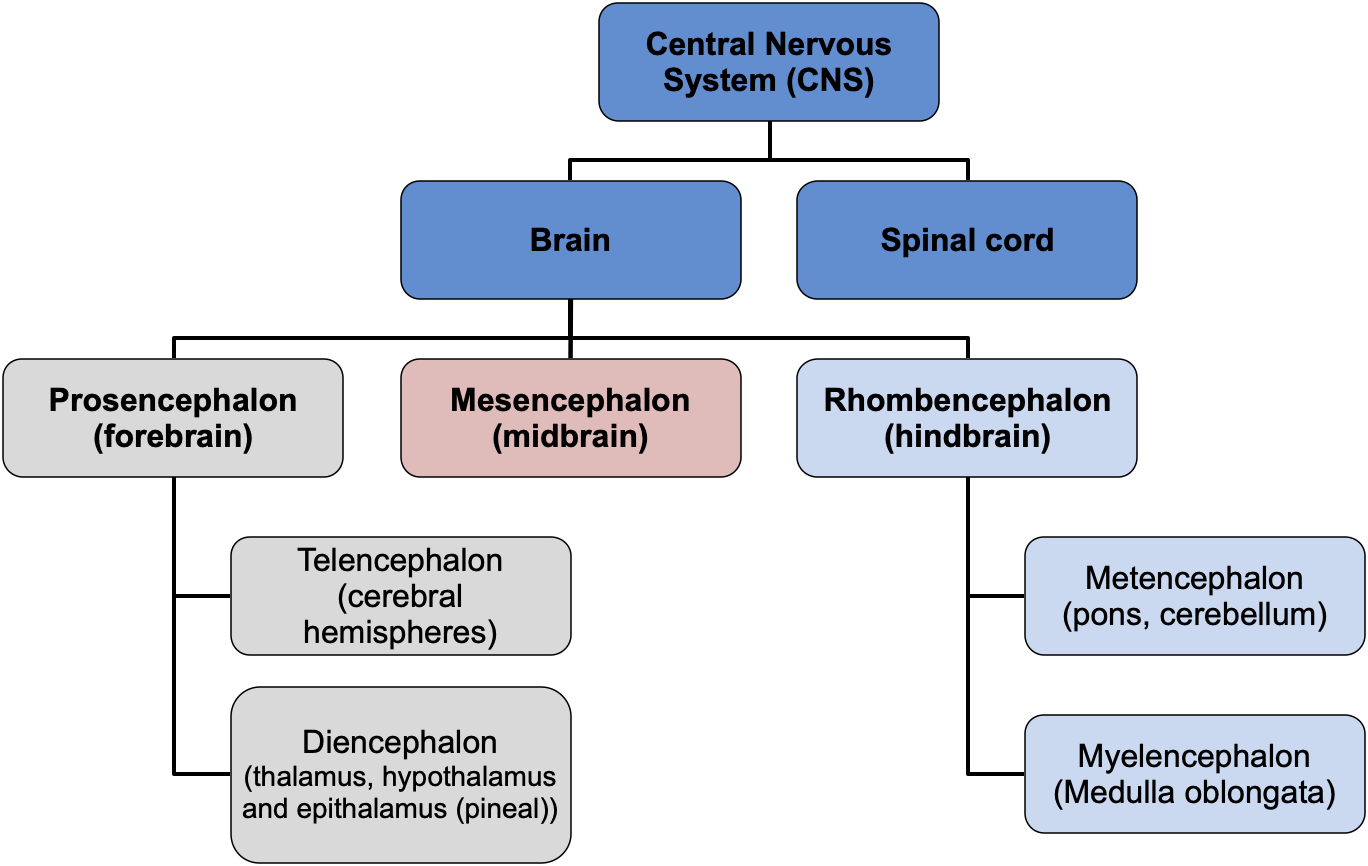
What are the 4 main divisions of the ADULT brain? What do they control?
Cerebrum
Higher control centre
Mediates cognition/thought processing
Receives and interprets sensory info
Initiates VOLUNTARY muscle action
Interacts with limbic system (moods, fear, pleasure, and memory)
Divided into Left and right hemispheres
Cerebellum
gate/balance/tone
Monitors position in space AND controls adjustments
Can influence speech
SMOOTH MUSCLE MOVEMENT
Diencephalon
processing information (sensory/motor)
Circadian and sleep wake cycle
Integrates endocrine and nervous systems
Thalamus acts as a relay centre
Hypothalamus endocrine centre
Brainstem
controls body physiology
Breathing/heart rate etc
Midbrain
Pons
Medulla oblongata
What are the 2 main physical differences between the brains of higher mammals and lower mammals?
In higher mammals the cerebrum has hills (Gyri) and valleys (sulci)
Deeper sulci provide boundaries for the lobes of the brain
Lower mammals have smoother surfaces
Folding greatly enhances the surface area and vastly increases the potential for neuronal networks
What does species variation in brain anatomy typically indicate?
The brains are organized in a way that is SUITABLE FOR THEIR LIFESTYLE
Specific regions evolved to achieve complex cognition where needed; depends on animal’s lifestyle
Cerebrum - higher thought
Cerebellum - gait and tone
Limbic system - emotion and memory
Some species can also have specific, specialized pathways
Ex: crows can problem solve
Ex: salmon, though smooth brain, can return to the same spawn site after years at sea
The cerebrum is divided into several lobes, whose boundaries are defined by major fissures and smaller sulci… what are the 4 major landmarks that divide the forebrain into lobes?
1) Longitudinal fissure
Divides the brain into the 2 main hemispheres
2) Cruciate sulcus
Only called this in animals… termed the “central sulcus” in humans
Placed ACROSS the brain, perpendicular to the longitudinal fissure
Defines the division between the frontal and parietal lobes (can be seen on dorsal view)
3) Lateral sulci (aka Sulcus Sylvius)
Seen on the lateral aspect in the center of the brain (see image)
Separates the temporal lobe from the frontal and parietal lobes
4) Rhinal sulcus
Separates the olfactory lobe from the rest of the forebrain… is MUCH more pronounced in dogs
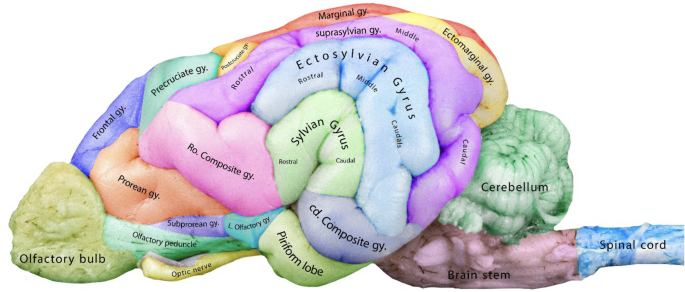
What are the 5 lobes of the canine brain? What are their functions?
1) Olfactory lobe (bulb)
smell
2) Frontal lobe
Higher functions:- behaviour, speech, problem solving
Voluntary movement / motor functions
3) Parietal lobe
Involved in perceiving sensory input such as touch, temperature
Associated with movement and orientation
4) Temporal lobe
Processes sound, vestibular sensations, smells (olfaction).
Also involved in perception and emotion
5) The occipital lobe:
Processing visual information
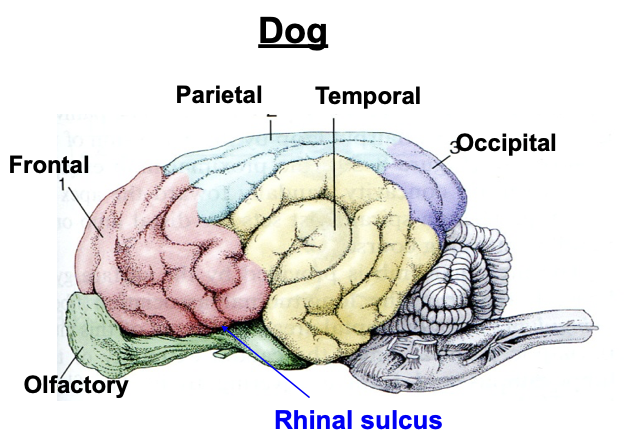
Describe the dorsal anatomy of the brain… What 3 major characteristics can be clearly identified?
1) Longitudinal fissure
2) Left and right hemispheres
3) CRUCIATE SULCUS
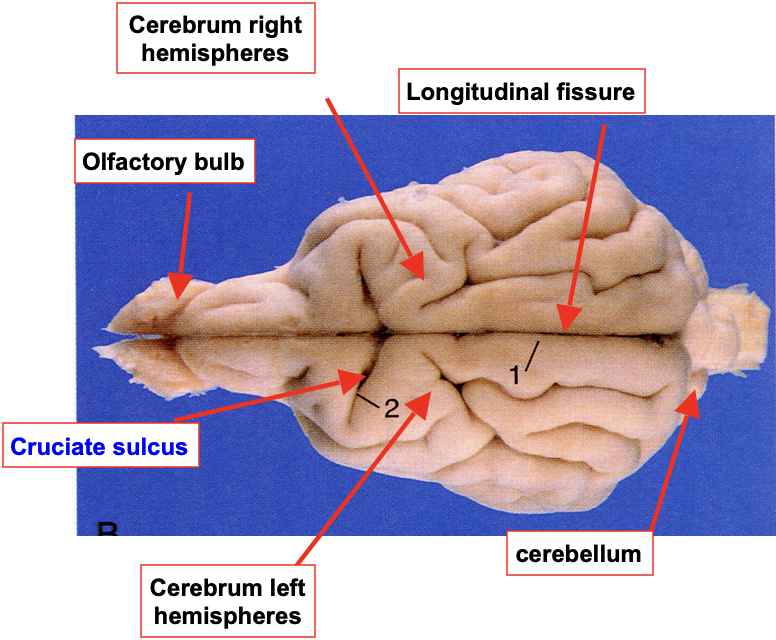
Describe the lateral anatomy of the brain… what 5 major characteristics can be clearly identified?
1) Olfactory bulb
MUCH more pronounce in dogs; transports odor signals to the cerebrum
2) Rhinal sulcus
3) SYLVIAN GYRUS
4) Cerebellum
5) Brain stem
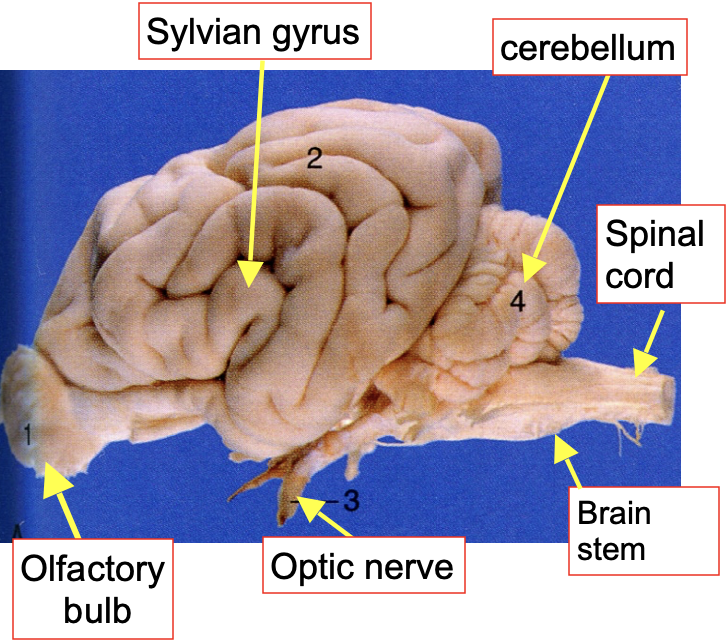
Describe the ventral view of the brain… what are the 5 main characteristics that can be clearly identified? Give a brief description of each…
1) Pituitary gland
Nestled into the center of the brain, between the optic chiasm and the midbrain
2) Optic chiasm
An X-shaped structure at the base of the brain, where the two optic nerves partially cross
3) Midbrain
Smallest part of the brainstem
Is responsible for processing sensory information and controlling motor control and involuntary actions, like eye movement
4) Pons
Between the midbrain and medulla oblongata; acts as a bridge between the two
Also has neurological function and contains important nerve connections for cranial nerves
5) Medulla oblongata
The lower and longest part of the brainstem
Connects the brain to the spinal cord
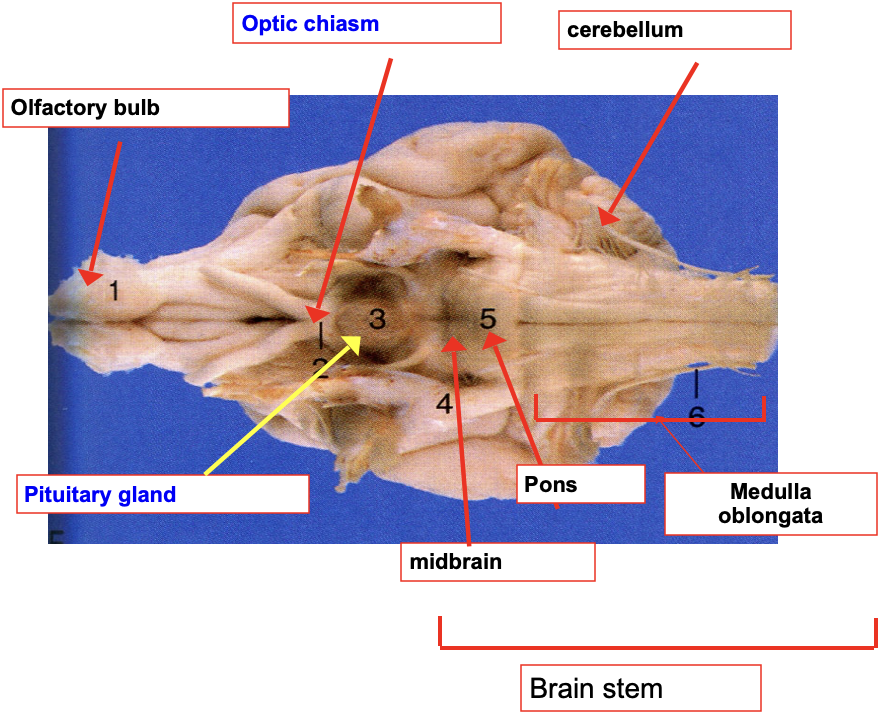
What are the 3 main components of the brainstem? Overall, what neurological functions does it serve?
Brainstem is composed of the midbrain, pons, and medulla oblongata
Function:
Controls most involuntary actions
Breathing, coughing, sneezing, eye movement, sleep-wake cycles, facial expressions
Also processes stimuli via cranial nerves
Interacts w/ optic nerves and olfactory bulb
Important for physiological function
Regulates heart rate / bp
Also interacts with the pituitary gland
What secondary vesicle forms the inside of the brain? What are the 6 major structures it contains?
The diencephalon is the internal portion of the brain.
Associated structures:
1) Epithalamus
Forms the roof of the diencephalon
Associated with the pineal gland (light sensitive; controls circadian rhythm and melatonin release)
2) Thalamus
Relay station for sensory INPUTS and motor OUTPUTS
3) Pituitary
4) Hypothalamus
Autonomic and endocrine control; MAINTAINS BODY HOMEOSTASIS
5) The Limbic System (and associated structures)
Hippocampus
Amygdala
6) Corpus callosum
Thick tract between the left and right hemispheres
Shares info between the two sides

What is “white matter” of the brain mainly composed of? Overall, what is its function?
White matter is mainly composed of axons of neurons
Function: connects different regions of the brain together; is essentially what allows the brain to function
What are 4 major structures of white matter that can be found in the brain? What is there function?
Corpus callosum
Connect left and right hemispheres found only in placental mammals (not marsupials/monotremes or reptiles, birds, etc)
Internal capsule
Connect cerebral hemispheres with brain stem
Peduncles of the cerebellum
Connects cerebellum with pons and medulla oblongata
Corona radiata
Can associate with the internal capsule to relay information to and from cerebrum via thalamus and brainstem
Is essentially the fan-like branches of white matter that connects the cerebral cortex to the internal capsule

What is the rostral colliculus within the brain? What is the caudal colliculus?
Rostral colliculus (latin small hill)
Relays visual information to the visual cortex
Caudal colliculus
Relays auditory information
e.g. movement of head towards sound
What is the deep nuclei of the brain? What 2 major characteristics is it composed of, and what are their functions?
The deep nuclei is an organized cluster of neurons
Composed of the:
Basal ganglia
Mass of grey matter within the cerebrum
Controls fine movement/balance/Tone and motivation/reward
Receives signals from motor cortex
Area of damage in Parkinson's Disease
Limbic system including hippocampus
Emotion and memory (rabies virus)
Hippocampus affected in Alzheimer's disease
Describe the thalamus of the brain… what are some defining characteristics? What, in general, does it do?
Thalamus is bilobed structure
Connection between called interthalamic adhesion
Visible in mid sagittal section
Sensory information (not olfaction) converge on thalamus
From thalamus directed to region of cortex
Thalamus composed of nuclei-clusters of neurones receiving inputs
Has multiple regions that perform different functions
Some nuclei connects to midbrain
e.g lateral geniculate nuclei and vision
What are the 3 main functions of the hypothalamus?
Autonomic NS control
Endocrine function
Controls homeostasis